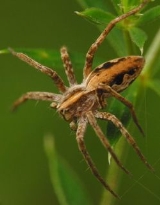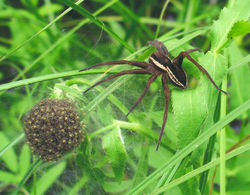
Nursery web spider
Encyclopedia
Nursery web spiders are spider
s of the family Pisauridae. They resemble wolf spider
s (family Lycosidae), but they carry their egg
sacs by means of their jaw
s and pedipalp
s (instead of attaching them to their spinnerets). When the eggs are about to hatch, a mother spider will build a nursery "tent," put her egg sac inside, and mount guard outside. The name nursery web spider is especially given to the European species Pisaura mirabilis
, but the family also includes fishing spiders and raft spider
s.
Unlike the wolf spiders, which have two very prominent eyes in addition to the other six, the eyes of the nursery web spiders are more or less the same size. Many species are able to walk on the surface of still bodies of water, and may even dive beneath the surface for a time to escape enemies. In escaping predators, they may very well jump a distance of five or six inches. However, they do not find it easy to make their way up extremely smooth surfaces such as glass
. The female spider will sometimes attempt to eat the male after mating. The male, to reduce the risk of this, will often present the female with a gift such as a fly when approaching in the hope that this will satisfy her hunger, and sometimes this gift is a fake present intended to fool the female.
Spider
Spiders are air-breathing arthropods that have eight legs, and chelicerae with fangs that inject venom. They are the largest order of arachnids and rank seventh in total species diversity among all other groups of organisms...
s of the family Pisauridae. They resemble wolf spider
Wolf spider
Wolf spiders are members of the family Lycosidae, from the Ancient Greek word "" meaning "wolf". They are robust and agile hunters with good eyesight. They live mostly solitary lives and hunt alone. Some are opportunistic hunters pouncing upon prey as they find it or even chasing it over short...
s (family Lycosidae), but they carry their egg
Egg (biology)
An egg is an organic vessel in which an embryo first begins to develop. In most birds, reptiles, insects, molluscs, fish, and monotremes, an egg is the zygote, resulting from fertilization of the ovum, which is expelled from the body and permitted to develop outside the body until the developing...
sacs by means of their jaw
Jaw
The jaw is any opposable articulated structure at the entrance of the mouth, typically used for grasping and manipulating food. The term jaws is also broadly applied to the whole of the structures constituting the vault of the mouth and serving to open and close it and is part of the body plan of...
s and pedipalp
Pedipalp
Pedipalps , are the second pair of appendages of the prosoma in the subphylum Chelicerata. They are traditionally thought to be homologous with mandibles in Crustacea and insects, although more recent studies Pedipalps (commonly shortened to palps or palpi), are the second pair of appendages of the...
s (instead of attaching them to their spinnerets). When the eggs are about to hatch, a mother spider will build a nursery "tent," put her egg sac inside, and mount guard outside. The name nursery web spider is especially given to the European species Pisaura mirabilis
Pisaura mirabilis
The nursery web spider Pisaura mirabilis is a spider species of the family Pisauridae.Males of this species offer food gifts to potential female mates. Some Pisaura mirabilis have also been observed to feign death, remaining still while holding the food gift in their mouths...
, but the family also includes fishing spiders and raft spider
Raft spider
The raft spider, Dolomedes fimbriatus, is a European spider of the family Pisauridae. The raft spider is one of the two largest spiders in the United Kingdom...
s.
Unlike the wolf spiders, which have two very prominent eyes in addition to the other six, the eyes of the nursery web spiders are more or less the same size. Many species are able to walk on the surface of still bodies of water, and may even dive beneath the surface for a time to escape enemies. In escaping predators, they may very well jump a distance of five or six inches. However, they do not find it easy to make their way up extremely smooth surfaces such as glass
Glass
Glass is an amorphous solid material. Glasses are typically brittle and optically transparent.The most familiar type of glass, used for centuries in windows and drinking vessels, is soda-lime glass, composed of about 75% silica plus Na2O, CaO, and several minor additives...
. The female spider will sometimes attempt to eat the male after mating. The male, to reduce the risk of this, will often present the female with a gift such as a fly when approaching in the hope that this will satisfy her hunger, and sometimes this gift is a fake present intended to fool the female.
Taxonomy
Family Pisauridae- Subfamily Pisaurinae Simon, 1890
- Afropisaura Blandin, 1976
- Architis Simon, 1898
- Caripetella Strand, 1928
- Charminus Thorell, 1899
- Chiasmopes Pavesi, 1883
- Cispius Simon, 1898
- Cladycnis Simon, 1898
- Dendrolycosa Doleschall, 1859
- Euprosthenops Pocock, 1897
- Euprosthenopsis Blandin, 1974
- Eurychoera Thorell, 1897
- Maypacius Simon, 1898
- Paracladycnis Blandin, 1979
- Perenethis L. Koch, 1878
- Phalaeops Roewer, 1955
- PisauraPisauraPisaura is a genus of Eurasian spiders in the family Pisauridae.-Species:* Pisaura acoreensis Wunderlich, 1992 — Azores* Pisaura anahitiformis Kishida, 1910 — Japan* Pisaura ancora Paik, 1969 — Russia, China, Korea...
Simon, 1885 - Pisaurina Simon, 1898
- Polyboea Thorell, 1895
- Ransonia Blandin, 1979
- Rothus Simon, 1898
- Staberius Simon, 1898
- Stoliczka O. P.-Cambridge, 1885
- Tetragonophthalma Karsch, 1878
- Thalassiopsis Roewer, 1955
- Voraptipus Roewer, 1955
- Vuattouxia Blandin, 1979
- WalrenceaBlandin, 1979

- Subfamily Thalassiinae
- Archipirata Simon, 1898
- DolomedesDolomedesDolomedes is a genus of large spiders of the family Pisauridae. They are also known as fishing spiders, raft spiders, dock spiders or wharf spiders. Almost all Dolomedes species are semi-aquatic, with the exception of the tree-dwelling D. albineus of the southwestern United States...
Latreille, 1804 - Eucamptopus Pocock, 1900
- Hesydrimorpha Strand, 1911
- Ilipula Simon, 1903
- Megadolomedes Davies & Raven, 1980
- NukuhivaNukuhivaNukuhiva is a genus of pisaurid spiders with a single species that occurs only on the Marquesas Islands. It has been found on Nuku Hiva and on Ua Huka, a smaller island about 25 km to the east.-Name:...
Berland, 1935 - Papakula Strand, 1911
- ThalassiusThalassiusThalassius is a genus of spiders in the family Pisauridae.-Species:Thalassius Simon, 1885* Thalassius albocinctus — India to Philippines* Thalassius esimoni Sierwald, 1984 — Madagascar* Thalassius jayakari F. O...
Simon, 1885 - Thaumasia Perty, 1833
- Tinus F. O. P.-Cambridge, 1901
- Subfamily incertae sedisIncertae sedis, is a term used to define a taxonomic group where its broader relationships are unknown or undefined. Uncertainty at specific taxonomic levels is attributed by , , and similar terms.-Examples:*The fossil plant Paradinandra suecica could not be assigned to any...
- Bradystichus Simon, 1884
- Campostichommides Strand, 1911
- Cispinilus Roewer, 1955
- Conakrya Schmidt, 1956
- Dianpisaura Zhang, Zhu & Song, 2004
- †ExtinctionIn biology and ecology, extinction is the end of an organism or of a group of organisms , normally a species. The moment of extinction is generally considered to be the death of the last individual of the species, although the capacity to breed and recover may have been lost before this point...
Eopisaurella Petrunkevitch, 1958 (Early Eocene; Baltic amberBaltic amberThe Baltic region is home to the largest known deposit of amber, called Baltic amber or succinite, with about 80% of the world's known amber found there. It dates from 44 million years ago...
) - †Esuritor Petrunkevitch, 1942 (Early Eocene; Baltic amber)
- Hygropoda Thorell, 1894
- Hypsithylla Simon, 1903
- Inola Davies, 1982
- Nilus O. P.-Cambridge, 1876
- †PalaeoperenethisPalaeoperenethisPalaeoperenethis is an extinct monotypic genus of Nursery web spider family Pisauridae, and at present, it contains the single species Palaeoperenethis thaleri...
Seldon & Penney, 2009 (YpresianYpresianIn the geologic timescale the Ypresian is the oldest age or lowest stratigraphic stage of the Eocene. It spans the time between and , is preceded by the Thanetian age and is followed by the Eocene Lutetian age....
, British Columbia, Canada) - Qianlingula Zhang, Zhu & Song, 2004
- Tallonia Simon, 1889
- Tapinothele Simon, 1898
- Tapinothelella Strand, 1909
- Tapinothelops Roewer, 1955

